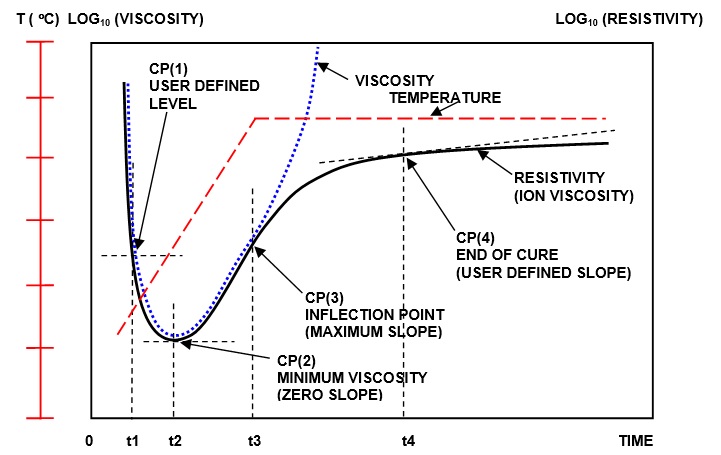DEA (Dielectric Analysis)라고 알려진 Dielectric cure monitoring는 실제 공정 조건에서 열 경화 재료 또는 복합 재료의 경화 거동과 상태를 실시간으로 분석할 수 있는 유일한 방법입니다. 따라서 본 유전율 분석기는 제조공정에 직접 적용할 수 있는 유의미한 데이터를 실험실에서 도출할 수 있습니다. 요약하자면 본 제품은 AC 신호를 사용해 열 경화 재료의 resistivity와 permittivity를 측정하여 유전체의 전기적 특성을 분석할 수 있습니다. Resistivity는 mobile ion의 유동성에 의해서 AC 신호에 독립적인 요소임과 동시에 stationary dipole rotation으로 인하여 AC 신호에 의존적인 요소이기도 합니다.
간결함을 위해 종종 DC resistivity라고 하지만, 교류 신호에 독립적인 resistivity는 실제로 DC(0 Hz)를 포함하는 주파수 범위에 걸쳐 확장됩니다. AC 신호에 독립적인 resistivity는 열 경화 재료, 복합적 경화 상태와 관련이 있어 흔히 ion viscosity라고 합니다. DC 측정과 달리 AC 측정은 전극 분극으로 인한 데이터 왜곡을 완화할 수 있고 release film이나 vacuum bag에도 적용이 가능합니다.

많은 경우에 log(IV)의 변화는 gelation 진행 전 mechanical viscosity의 변화에 비례하고, gelation 후 modulus 변화에 비례합니다. 따라서 DEA는 모든 공정에 걸쳐 재료의 경화 거동 분석이 가능합니다.
위의 도표는 온도 램프를 사용하여 경화 재료의 ion viscosity와 mechanical viscosity의 관계를 나타냅니다. 처음에 온도가 증가함에 따라 열 경화 재료가 더욱 유동적으로 변하여 resistivity가 감소합니다. 재료가 뜨거워질수록 반응 속도도 증가합니다.
때때로, polymerization에 의한 ion viscosity의 증가가 온도 상승에 의한 ion viscosity의 감소를 극복하기도 합니다. 이 지점은 ion viscosity 최소점이며, mechanical viscosity의 최소 시점에 발생합니다.
최소 지점 이후 ion viscosity는 반응이 가속됨에 따라 증가하며, 재료는 점성이 더 강해집니다. gelation에서 가교결합과 네트워크 형성 시작과 함께, mechanical viscosity는 측정할 수 없을 때까지 급속도로 증가하게 됩니다. 그러나 ion viscosity는 gel 지점을 지나는 경화 상태에 대한 정보를 계속 제공합니다.
반응하지 않는 monomer의 농도가 감소하고 가교결합의 범위가 늘어남에 따라 반응 속도도 감소합니다. 결과적으로 ion viscosity의 기울기는 감소하다가 경화 과정이 중단되면 0이 됩니다.
Dielectric cure monitoring, also known as Dielectric Analysis (DEA) is the only method that can measure thermoset or composite cure state in real time under actual process conditions. Consequently, DEA can generate results in the laboratory that are directly applicable in manufacturing. In brief, DEA uses an AC signal to measure a thermoset’s resistivity and permittivity, which are the material’s dielectric properties. Resistivity itself has a frequency independent component due to the flow of mobile ions and a frequency dependent component due to the rotation of stationary dipoles.
Although often called DC resistivity for brevity, frequency independent resistivity actually extends across a range of frequencies that includes DC (0 Hz). Frequency independent resistivity—more commonly called ion viscosity (IV)—correlates with thermoset or composite cure state, making it a useful material probe. By taking advantage of optimal frequencies, AC measurements—unlike DC methods—can deal with distortion of data caused by electrode polarization and can work through release films and vacuum bags.
In many cases the change of log(IV) is proportional to the change of mechanical viscosity before gelation and proportional to the change of modulus after gelation. Consequently, DEA enables composite cure monitoring throughout a process.
The figure above illustrates the relationship between ion viscosity and mechanical viscosity for a curing thermoset with one temperature ramp and hold. At first, as temperature increases, ion viscosity decreases because the resin becomes more fluid and therefore less resistive. The reaction rate increases as the material becomes hotter.
At some time, the increase in ion viscosity due to polymerization overcomes the decrease in ion viscosity due to rising temperature. This point is the ion viscosity minimum, which also occurs at about the time of minimum mechanical viscosity.
After the minimum, ion viscosity increases as the reaction accelerates and the material becomes more viscous. At gelation, with the start of crosslinking and network formation, the mechanical viscosity increases rapidly until it is unmeasurable. Ion viscosity, however, continues to provide information about cure state past the gel point.
As the concentration of unreacted monomers diminishes and crosslinking becomes more extensive, the reaction rate decreases; consequently, the slope of ion viscosity also decreases and eventually ion viscosity will have zero slope when the composite cure has stopped completely.
Reference :
Lambient TechnologiesTM Technical Overview 3.01—What is Dielectric Cure Monitoring (DEA)?, Page 2
상세한 사항은 아래 첨부된 자료를 참고 부탁 드립니다.
검색 결과 15건
- 분류 : 유전율측정기
하기
